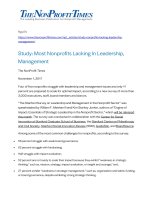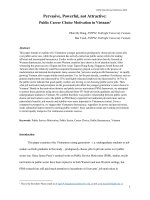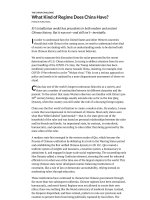Bài đọc 14.1. Science, Technology and Innovation for Sustainable Development (Chỉ có bản tiếng Anh)
Bạn đang xem bản rút gọn của tài liệu. Xem và tải ngay bản đầy đủ của tài liệu tại đây (849.33 KB, 14 trang )
<span class='text_page_counter'>(1)</span><div class='page_container' data-page=1>
<b>Science, technology and innovation </b>
<b>for sustainable development in the </b>
<b>global partnership for development </b>
<b>beyond 2015 </b>
<b>Thematic Think Piece </b>
<b>ITU,OHCHR, UNCTAD, UNEP, UNESCO, </b>
<b>UNFCCC, UNIDO, WIPO, WMO </b>
The views expressed in this paper are those of the signing agencies and
do not necessarily reflect the views of the United Nations.
</div>
<span class='text_page_counter'>(2)</span><div class='page_container' data-page=2></div>
<span class='text_page_counter'>(3)</span><div class='page_container' data-page=3>
<b>Science, technology and innovation for </b>
<b>sustainable development in the global </b>
<b>partnership for development beyond 2015 </b>
<b>A post-2015 agenda for development: Ensuring </b>
<b>equitable and inclusive globalization </b>
Debates on how best to promote sustainable and inclusive development are incomplete
without a full consideration of issues of science, technology and innovation (STI). Access to
new and appropriate technologies promote steady improvements in living conditions,
which can be lifesaving for the most vulnerable populations, and drive productivity gains
which ensure rising incomes.
There are two essential STI issues that need to be tackled simultaneously in the post-2015
development agenda. Firstly, innovation driven growth is no longer the prerogative of high
income countries alone, some developing countries have achieved significant economic
growth through the creation and deployment of STI capacity. But, this has not been the
case for all countries, in particular LDCs. Secondly, STI policy has often been pursued
independently of the broader developmental agenda; it is important that STI be integrated
into public policy goals, giving particular focus to the nexus between STI, culture, education
and development.
</div>
<span class='text_page_counter'>(4)</span><div class='page_container' data-page=4>
<b>Technological learning and innovation capacity: a </b>
<b>cross-cutting issue for inclusive development </b>
<b>The technological challenge and global public goods1</b>
In the MDGs, issues of science and technology have focused predominantly on access to
essential medicines (particularly for the treatment of HIV/AIDS) and on internet
connectivity and the related spread of communication technologies (ICTs). The favoured
approach has been through needs assessment and targeted capacity building.
However, delivering on the full range of amenities which underpin the MDG agenda,
including, inter alia, environmental protection, the containment of health epidemics,
mitigating climate change, requires access to a range of appropriate technologies. Much of
the required technology is already available in the public domain but accessing and linking
them to the required knowledge and skills within countries is neither automatic nor
costless. It calls for investments in dynamic capabilities, particularly those that
shape the ability of national stakeholders to uptake and absorb technol ogies and
make improvements in line with local circumstances. This is not a one-way process.
Some level of technological capabilities in countries is critical to ensure the provision of
these amenities to all. At the same time, the critical importance of such amenities spans
beyond individual countries or regions. In such a case, the international community as such,
has a collective responsibility to ensure the provision of these goods (Stiglitz, 2007, among
others).2
Within the UN Framework Convention on Climate Change, the new Technology Mechanism
established by the Cancun Agreements in December 2010 represents a move towards a
1<sub> Public goods are those goods that exhibit non-rivalrous consumption (the use by one individual does not </sub>
diminish the availability of the resource to another) and non-excludability (when it is difficult to exclude
people from consuming the good). The notion of global public goods is a recent concept that builds on
established economic literature on public goods; public goods are referred to as global public goods when they
have benefits that are universal in nature spanning across countries and people. While the boundaries of the
term ‘global public goods’ is still being debated, the fundamental idea is that for those goods that can be called
as such, the international community has a collective responsibility to ensure the provision of those goods (See
for example, Stiglitz, 2007).
2 <sub>Stiglitz, J.E.,' Knowledge as a Global Public Good' in International Intellectual Property in an Integrated World </sub>
</div>
<span class='text_page_counter'>(5)</span><div class='page_container' data-page=5>
more 'dynamic' arrangement by fostering public-private partnerships; promoting
innovation; catalyzing the use of technology road maps or action plans; mobilizing national,
regional and international technology centres and network; and facilitating joint R&D
activities. Scaling-up and extending this kind of approach will be a central part of the
post-2015 global partnership.
<b>Innovation and Growth: Value Creation </b>
In addition to its role in providing global public goods, science, technology and innovation
(STI) serves as a crucial driver of rising prosperity and improved national competitiveness.
However, because technological knowledge and skills are cumulative, first mover
advantages have created a very uneven global landscape. Connecting local technological
needs to international technological opportunities is a particular challenge for many
developing countries.
<i>A well functioning STI ecosystem needs to include, inter alia, political stability and </i>
well-functioning institutions, an educated workforce; sound research and education
infrastructure and linkages between public and private innovation actors; enterprises
committed to research and development; as well as a balanced intellectual property rights
(IPRs) framework. Given that knowledge exhibits several properties of a public good, there
is a persistent danger of underinvestment, and policymakers have increasingly sought to
improve the incentives to create and transfer knowledge from publicly funded research to
enterprises, thereby reinforcing the impact of that research on innovation capacity. But in
addition to national strategies, regional and international frameworks including the UN
and its agencies, funds and programmes must respond in new ways to ensure that
innovation is integrated into national development priorities, particularly in least
developed countries (LDCs), where the technological divide is greatest. These varied
<i>responses are required because STI ecosystems have become more complex and are now </i>
built on a mixture of collaboration and competition involving market incentives but also
private and public partnerships across borders.
</div>
<span class='text_page_counter'>(6)</span><div class='page_container' data-page=6>
and dissemination of technological information. It is as such a key element of the
ecosystem. But it is not an end in itself. Commitment to the protection of intellectual
property through cooperation among states should be coupled with a commitment to
ensuring that all countries are able to benefit from the use of intellectual property rights
for economic, social and cultural development. Finding the right balance between
accessibility and reward (for creativity and innovation) remains a fundamental challenge
in building inclusive and sustainable development paths. Given that appropriate
intellectual property policies are context specific there is also a need to ensure that, for
those countries that request it, appropriate technical assistance is available to make most
effective use of the IP system, especially in order to be able to foster national
developmental goals.
<b>Technology and innovation for catch-up growth </b>
Technological change, particularly in developing countries, is not only about innovating at
the frontier, but also about adapting existing products and processes to achieve
higher levels of productivity as applicable to their local contexts. In this process, the ability
of local firms and enterprises to access technological know-how is fundamental to shaping
their ability to provide products and services, both of the kind that are essential to improve
living standards, and that could also promote growth and competitiveness.
This requires investment not only in higher value manufacturing industries but also into
sectors that contribute to broader public policy goals (such as health, agriculture, nutrition
and environment) as well as across a range of activities that support overall development,
including also marketing, management and financial services. Such investments, over a
period of time, help to increase absorptive capacity and the ability to adapt and apply
existing technologies, thereby leading to a gradual increase in productivity and social
welfare.
</div>
<span class='text_page_counter'>(7)</span><div class='page_container' data-page=7>
primary and high school levels to the encouragement of research poles around existing
universities is one key step. Second, partnerships with university research institutes and
industry will be a key driver of improving the overall ecosystem making it attractive for
human skills to return, including the return of skilled labour from developed to developing
countries. Third, broadening the culture of science, technology and innovation is also
important. Fourth, science and technology must be accessible to all levels of learning,
including to the public through the media to show how research can drive high technology
innovation and wealth creation. Finally, knowledge sharing both nationally and
internationally is critical. This can be promoted through ICTs and broadband networks,
particularly the application of technology-supported learning (eLearning), which can
increase the effectiveness of education, including its outreach and awareness-raising.
<b>Bridging the technological divide through access to </b>
<b>technologies </b>
The question of promoting equitable global economic development has always been seen
in conjunction with promoting access to the knowledge base in those countries at the
technological frontier. But bridging the technological divide has been an uphill, and for
many countries a frustrating, endeavor. However, the experiences gathered over the past
few decades, both within countries and at the international level, are valuable in charting a
future course. Of these, some of the most essential ones are summarized here.
Learning opportunities for innovation arise regularly from a variety of sources, such as
from investments in new machinery and equipment, technology suppliers, mobility of
labour, interactions with other knowledge agents, trade and investment. External
opportunities, such as contract manufacturing for export and supplying to global value
chains, are additional sources of learning. However, because learning does not occur
automatically or without costs, it requires appropriate incentives, policies and institutions.
</div>
<span class='text_page_counter'>(8)</span><div class='page_container' data-page=8>
underlying network of all actors, economic and non-economic, interactions among whom is
critical to promote learning and knowledge accumulation.
Trade rules, intellectual property rights and investment are means to achieve overall
development, including through technological change. There is a need to ensure that they
are coherent with overall technological development objectives of countries.There is also a
need for efforts to ensure that existing agreements maximize policy space and, where
appropriate, expand it in sectoral areas of interest to developing countries to ensure
inclusive, sustainable development.
A range of international collaborative ventures and alliances can help address the creation
and dissemination of technologies in sectors of public importance, especially health and
agriculture. STI partnerships can play a critical role. As the United Nations Task Force on
Science, Technology and Innovation noted, innovation and technology are needed to
transform countries from reliance on the exploitation of natural resources to technological
innovation as the basis for development. However, some recent empirical research
conducted by the World Bank has sought to explain the relative scarcity of STI
partnerships. The research concludes that efforts to promote partnerships have been ad
hoc and partnerships have been limited in their capacity to promote broad, systemic
improvement. Such partnerships have also not always been sustainable in generating a
legacy since partnership programs often operate in isolation from related donor activities
taking place simultaneously in the countries. Finally, partnerships are not always linked to
the priority needs of developing countries. These weaknesses of partnership programs
need to be addressed if they are to deliver effective results and build capacity.
<b>Bridging the technological divide by promoting </b>
<b>inclusive innovation </b>
<b>Promoting inclusive innovation within countries </b>
</div>
<span class='text_page_counter'>(9)</span><div class='page_container' data-page=9>
market.3<sub> The future holds other challenges where new technologies will be key, </sub>
particularly where climate change is involved. In both traditional and frontier markets,
competition between innovators will be critical to ensure the development of socially
useful products and processes at affordable prices. However, for many developing
countries, persistent obstacles will need to addressed through a global partnership for
development.
The first of these is financing acquisition and innovation. In a large number of developing
countries, shallow financial markets often thwart their responses to developmental needs.
It remains imperative that the challenge of mobilizing such financial resources for
technological development form a significant part of the post-2015 agenda.
A second obstacle is incentives. Where there is a strong market pull, commercial drivers
encourage a diversity of approach. However, in addressing some of the key development
challenges, market incentives may not be sufficiently strong to drive the necessary
innovation. Where markets are not strong, additional approaches are needed to bridge the
gap. We see this clearly in the lack of development of new treatments for neglected tropical
diseases. But a similar situation may occur with any technology needed to address the
needs of poor populations. In a world where the primary incentives for innovation are
market-based, the inability-to-pay often translates into an inability-to-access. There is a
need for a proactive policy agenda that focuses innovation on the needs of poor
populations and makes the products of that innovation more readily available to those who
need it.
A third obstacle is information. Data covering the three pillars of sustainable development
needs to be collected, harmonized, managed and integrated in a more coherent way to
support better policy-making and decision-making. The issue of access to information has
<i>been addressed in The Future We Want4</i> and the public-right-to-know is fundamental in
engaging all relevant stakeholders in sustainable development. The technology exists for
collecting economic, environmental and social data and making it accessible for all via the
3
</div>
<span class='text_page_counter'>(10)</span><div class='page_container' data-page=10>
web but there is a challenge to change attitudes and cultures within those ministries and
agencies responsible for data collection so that the sharing and exchange of information
across the three pillars can result in synergies and bring increased benefits for a wide
spectrum of users from policy-makers to the business community to citizens. Mobile
learning and the use of mobile devices for communicating data and information for
sustainable development has enormous potential. One challenge is to provide content in a
format suitable for quick and easy comprehension by the user.
Partnerships are critical to overcoming these market failures. In the field of health a range
of Product Development Partnerships (PDP), several involving the UN system and its
agencies, have been formed to promote the development and distribution of treatments,
therapies and vaccines for diseases which otherwise would have been “neglected”. While
the PDP model has had some success in the health field, in other sectors, other models have
been tested including by national governments in several countries such as India, China,
Brazil and Chile, among others. Alternatively, institution led models such as the Global
Research Alliance which addresses global development challenges through inclusive
innovation generated within its global and culturally diverse network has also started to
deliver results.
</div>
<span class='text_page_counter'>(11)</span><div class='page_container' data-page=11>
<b>Conclusion </b>
Lives saved and nourished will not be able to flourish in the absence of inclusive and
sustained development that creates jobs, builds skills and reduces poverty. This is perhaps
the most important lesson of the past decade.
Any effective global partnership supporting inclusive development therefore needs to
frame development for all as the overall goal. This will need a rebalance of priorities and
concerns globally to achieve a paradigm shift where the relevance of cross-cutting issues,
such as technology and innovation, is not contestable.5<sub> Such a new global deal will need </sub>
fresh thinking, supported by effective policies and instruments in order to provide a
roadmap for action. Whether a set of narrowly defined targets will help to accomplish this
purpose will need to be debated.
The issues raised by this think piece will be essential in framing this debate, the most
urgent of which are provided here in a snapshot.
The objective of achieving overall development and the MDGs as they stand currently have
a virtuous relationship. A new global deal is needed that promotes the virtuous cycle of
achieving each of these individual targets that are essential for the wellbeing of people in
conjunction with creating an overall environment that promotes overall progress and
prosperity. Such a new global deal will need fresh thinking, supported by effective policies
and instruments in order to provide a roadmap for action.
Technological learning and innovation capacity that is critical to enable the provision of
essential amenities to all is fundamental to ensuring overall sustainable development.
Simply put, a country develops capabilities to innovate, and the absence of such
capabilities results in limitations to apply existing technologies in all sectors, including
those of public importance, such as health, agriculture and climate change. Building
5
</div>
<span class='text_page_counter'>(12)</span><div class='page_container' data-page=12>
technology and innovation capacity within countries as a whole should therefore be
considered as an important international priority in the post-2015 agenda.
Many of the countries that have tremendous constraints in mobilizing financial resources
are those that urgently need to build STI capabilities. The international community will
have to step in to fill this gap. These financial commitments are currently lacking even
within sectors such as climate change or energy access, where financing innovation
capacity needs to become a priority if sustainable development is to be achieved.
Aligning the interests of the private sector with the overall need to promote access to
existing technologies and create products and services aimed at markets with little or no
ability to pay is no easy task. Left on their own, these interests will most likely not
converge. There is a need to rethink how best to diffuse existing technologies as well as
promote access to new technologies for all. Whether embodied as products or processes or
in the form of knowledge transfers, such exchange holds the key for a sustainable and
prosperous future for all.
</div>
<span class='text_page_counter'>(13)</span><div class='page_container' data-page=13>
<b>UN System Task Team on the Post-2015 UN Development Agenda </b>
<b>Membership </b>
<i>Department of Economic and Social Affairs (DESA), Co-Chair </i>
<i>United Nations Development Programme (UNDP), Co-Chair </i>
<i>Convention on Biological Diversity (CBD) </i>
<i>Department of Public Information (DPI) </i>
<i>Economic Commission for Africa (ECA) </i>
<i>Economic Commission for Europe (ECE) </i>
<i>Economic Commission for Latin America and the Caribbean (ECLAC) </i>
<i>Economic and Social Commission for Asia and the Pacific (ESCAP) </i>
<i>Economic and Social Commission for Western Asia (ESCWA) </i>
<i>Executive Office of the Secretary-General (EOSG) </i>
<i>Food and Agricultural Organization of the United Nations (FAO) </i>
<i>Global Environment Facility (GEF) </i>
<i>International Atomic Energy Agency (IAEA) </i>
<i>International Civil Aviation Organization (ICAO) </i>
<i>International Fund for Agricultural Development (IFAD) </i>
<i>International Labour Organization (ILO) </i>
<i>International Maritime Organization (IMO) </i>
<i>International Monetary Fund (IMF) </i>
<i>International Organization for Migration (IOM) </i>
<i>International Telecommunication Union (ITU) </i>
<i>Joint United Nations Programme on HIV/AIDS (UNAIDS) </i>
<i>Non-Governmental Liaison Service (NGLS) </i>
<i>Office of the Deputy Secretary-General (ODSG) </i>
<i>Office of the High Commission for Human Rights (OHCHR) </i>
<i>Office of the High Representative for the Least Developed Countries, Landlocked Developing </i>
<i>Countries and Small Island Developing States (OHRLLS) </i>
<i>Office of the Special Advisor on Africa (OSAA) </i>
<i>Peace building Support Office (PBSO) </i>
</div>
<span class='text_page_counter'>(14)</span><div class='page_container' data-page=14>
<i>United Nations Convention to Combat Desertification (UNCCD) </i>
<i>United Nations Educational, Scientific and Cultural Organization (UNESCO) </i>
<i>United Nations Entity for Gender Equality and Empowerment of Women (UN Women) </i>
<i>United Nations Environment Programme (UNEP) </i>
<i>United Nations Framework Convention on Climate Change (UNFCCC) </i>
<i>United Nations Fund for International Partnerships (UNFIP) </i>
<i>United Nations Global Compact Office </i>
<i>United Nations High Commissioner for Refugees (UNHCR) </i>
<i>United Nations Human Settlements Programme (UN-HABITAT) </i>
<i>United Nations Industrial Development Organization (UNIDO) </i>
<i>United Nations International Strategy for Disaster Reduction (UNISDR) </i>
<i>United Nations Institute for Training and Research (UNITAR) </i>
<i>United Nations Millennium Campaign </i>
<i>United Nations Office for Outer Space Affairs (UNOOSA) </i>
<i>United Nations Office for Project Services (UNOPS) </i>
<i>United Nations Office on Drugs and Crime (UNODC) </i>
<i>United Nations Population Fund (UNFPA) </i>
<i>United Nations Relief and Works Agency for Palestinian Refugees in the Near East (UNRWA) </i>
<i>United Nations Research Institute for Social Development (UNRISD) </i>
<i>United Nations System Chief Executives Board for Coordination Secretariat (CEB) </i>
<i>United Nations University (UNU) </i>
<i>United Nations Volunteers (UNV) </i>
<i>United Nations World Tourism Organization (UNWTO) </i>
<i>Universal Postal Union (UPU) </i>
<i>World Bank </i>
<i>World Food Programme (WFP) </i>
<i>World Health Organization (WHO) </i>
</div>
<!--links-->









